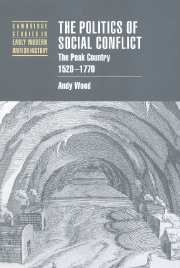Book contents
- Frontmatter
- Contents
- List of figures
- List of tables
- List of maps
- Preface
- List of abbreviations
- Introduction ‘Terms we did not understand’: landscape, place and perceptions
- 1 Social relations and popular culture in early modern England
- Part I The structures of inequality
- Part II The conditions of community
- 6 ‘The memory of the people’: custom, law and popular culture
- 7 The politics of custom
- 8 Community, identity and culture
- Part III The politics of social conflict
- Bibliography
- Index
- Cambridge Studies in Early Modern British History
8 - Community, identity and culture
Published online by Cambridge University Press: 27 July 2009
- Frontmatter
- Contents
- List of figures
- List of tables
- List of maps
- Preface
- List of abbreviations
- Introduction ‘Terms we did not understand’: landscape, place and perceptions
- 1 Social relations and popular culture in early modern England
- Part I The structures of inequality
- Part II The conditions of community
- 6 ‘The memory of the people’: custom, law and popular culture
- 7 The politics of custom
- 8 Community, identity and culture
- Part III The politics of social conflict
- Bibliography
- Index
- Cambridge Studies in Early Modern British History
Summary
GENDER, WORK AND IDENTITY
Both in free mining and in the large, deep mines which mushroomed across the lead field after the mid-seventeenth century, the household was central to the organization of labour in the mining industry. Qualitative and quantitative evidence suggests an average household size of five people in the late sixteenth and early seventeenth centuries. The contents of the miners' petition of 1641 allows for a closer scrutiny of the structure of mining households. In the case of 1,463 named miners, the structure of their households are described (see Table 8.1).
Unsurprisingly, given what is known of household formation in early modern England, the nuclear family predominated within the orefield in 1641. More unusually, few mining households of that year included servants, and none included any apprentices. Households which included servants tended to be headed by wealthier miners, and therefore were more likely to be found within the richer valley settlements. On the south-eastern margins of the lead field, where the mining industry may have remained in a state of flux in 1641, there was a higher proportion of shared households, perhaps suggesting a more fluid population than existed within the core of the lead field.
Whereas women's work underwent significant change in other areas of early industrialization, within the Peak after the mid-sixteenth century a basic continuity in the sexual division of labour within the mining house-hold is apparent.
- Type
- Chapter
- Information
- The Politics of Social ConflictThe Peak Country, 1520–1770, pp. 179 - 200Publisher: Cambridge University PressPrint publication year: 1999



